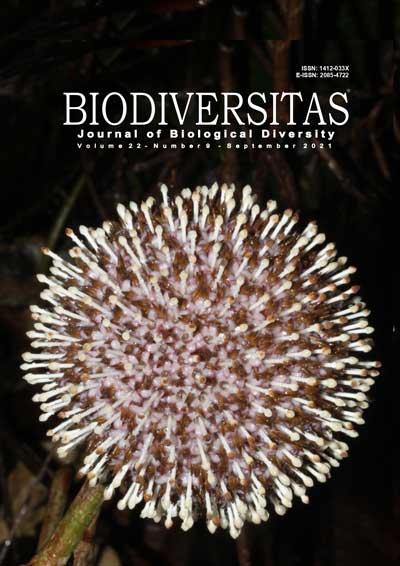Bacterial abundance and community composition in green, brown and red water from intensive catfish (Clarias sp.) culture ponds in Yogyakarta, Indonesia
##plugins.themes.bootstrap3.article.main##
Abstract
Abstract. Wijayanti KAN, Istiqomah I, Murwantoko. 2021. Bacterial abundance and community composition in green, brown and red water from intensive Catfish (Clarias sp.) culture ponds in Yogyakarta, Indonesia. Biodiversitas 22: 3677-3684. Catfish (Clarias sp.) is an important aquaculture commodity in Indonesia and cultured in an intensive system. Microorganisms play an important role in maintaining water quality of aquaculture system. The objective of this study was to determine the bacterial abundance and community composition of green, brown and red water collected from intensive catfish culture ponds in Yogyakarta using next-generation sequencing method. The water samples were collected from intensive catfish culture ponds with different colors, namely green, brown and red ponds located in Yogyakarta. The DNA from water samples was extracted using DNA extraction kit and used as template for 16S rRNA amplification. The V3-V4 hypervariable regions of the 16S rRNA gene were amplified apply for next-generation sequencing technology. This study could explore effectively the bacterial community in water samples. The bacterial communities in this catfish culture water showed higher bacterial richness compared to the other aquaculture system. The diversity of the green, brown and red catfish culture water ponds was similar with the number OTUs of the green, brown and red water samples, which were 1269; 1387 and 1323 OTUs respectively. The 694 OTUs (34.42%) were common core microbiomes in all catfish culture ponds, the 212 OTUs (10.51%) are present on green and brown water ponds, the 182 OTUs (9.02%) were on green and red water ponds, and the 183 OTUs (9.07%) were present on green and brown water ponds. However, the composition of the bacterial community was different. The most dominant phylum in green and brown water ponds was Proteobacteria with relative abundance in green water and brown water 71.6% and 47.0% respectively, whereas, the most dominant phylum in red water was Firmicutes (29.5%). The dominance of Firmicutes phylum in red water ponds may be caused by application of probiotic bacteria, the high organic content, and low oxygen concentration.
